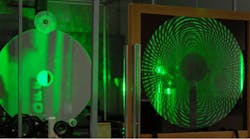Lightweight Membrane Optics Strengthen Telescope Stability
Image quality in space hinges on one key factor—a stable platform. On that front, the U.S. Defense Advanced Research Projects Agency (DARPA) Membrane Optic Imager Real-Time Exploitation (MOIRE) program aims to demonstrate the ability to decrease mass and costs of large imaging systems using lightweight diffractive membrane optics. In turn, these structures will provide the necessary stability for persistent imaging from geostationary orbit.
Ball Aerospace & Technologies Corp. recently completed thermal vacuum environmental tests on critical components for the DARPA MOIRE telescope. Two sections of the primary mirror composite back structure and the structure deployment hinges were tested to simulate the conditions of a space environment. ATK Space Components specifically designed the back structure to be lightweight but stable. Ball Aerospace developed the deployment hinges used to unfold the telescope primary in space.
Watch a concept video about MOIRE from DARPA below:
Strict limits are set on the size and weight of telescope components due to the massive cost and effort it takes to transport them to space. NeXolve created the packable, flexible membrane material used for the MOIRE optics. The 20-µm-thick polyimide membrane is virtually weightless, and features a near-zero coefficient of thermal expansion. When tested, diffraction efficiency pushed past 30%, approaching the theoretical 35% maximum efficiency for the design. Those results prompted the team to fabricate precision, large-scale membrane optics using the material.
Overall, the MOIRE program serves to develop technologies for large optic space platforms that reduce areal density by four to five times that of current systems. It also aims to examine technologies for manufacturing large membranes that hold optics flat, and the secondary elements needed to turn diffraction-based optics into a wide-bandwidth imaging device.
According to Rose Hansen, Lawrence Livemore National Laboratory, in her paper, “Developing Lightweight Optics for Space”:
The eventual goal for MOIRE is a space telescope with a 20-meter-diameter lens. With a space telescope of that size, astronomers could observe weather patterns on Saturn with 100-kilometer resolution or planetary nebula 600 light years away with 1-astronomical-unit resolution.
The MOIRE program began in March 2010 in two phases. Phase 1—completed in September 2011—verified the proof of concept for the program design. Phase 2—currently underway—helps reduce the various risks as well as plan for manufacturing.
